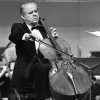Leonard Rose provides an in-depth exploration of the fundamental principles involved in producing sound. The three key interactive elements for creating good sound are pressure, bow speed, and sounding point (where the bow contacts the string between the bridge and fingerboard). These elements are interrelated, requiring adjustment for different playing situations. Rose emphasizes the importance of avoiding tightness in the shoulders and hands which negatively affect sound. He discusses how tension in the body, often starting in the neck or shoulders, leads to stiffness in the right hand and arm, preventing fluid movement and affecting sound quality. The body operates like springs—with flexibility in the hand, wrist, and thumb being crucial. He stresses the importance of not locking the hand, as rigidity results in a harsh, metallic sound.
Rose also discusses seating posture and how different body types require different adjustments. He explains that players need to rotate and lean slightly to maintain a proper angle when bowing, particularly on the A string, and emphasizes the importance of balance, noting that most of the body’s weight should gravitate toward the left side. Regarding the bow grip, Rose advocates for a flexible thumb and explains the importance of balancing the bow between the thumb and the middle fingers. He also teaches students to avoid playing with flat hair and to keep the bow in a slight tilt towards the bridge to create better sound. Finally, Rose addresses the importance of learning to use both halves of the bow. He concludes by highlighting the importance of patience in mastering the fundamentals slowly. He blends practical instruction with conceptual understanding, aiming to teach how to listen and adjust for better sound production.
About

Leonard Rose
“I was a pipsqueak of a kid and overwhelmingly shy. I was afraid to speak to Mr. Rose above a…
See More